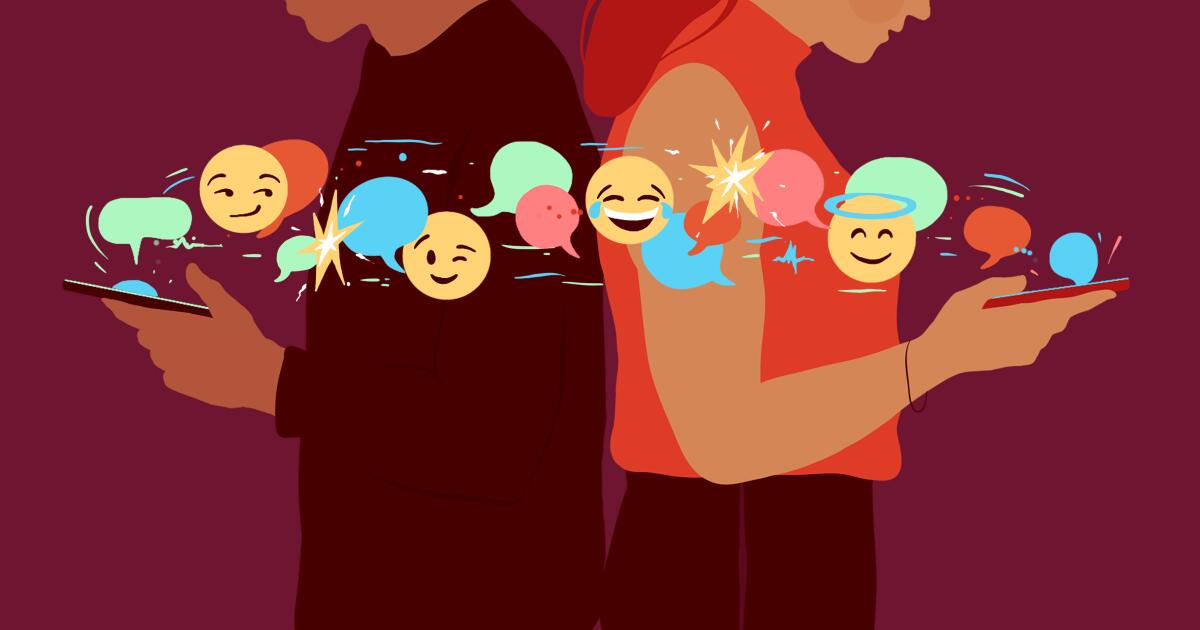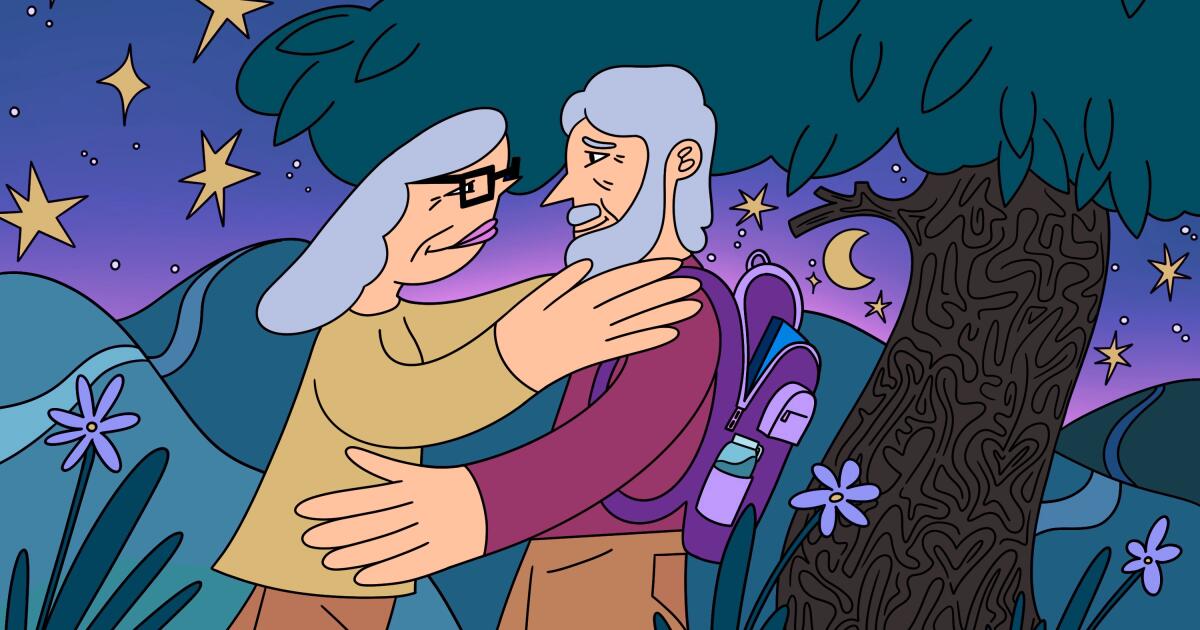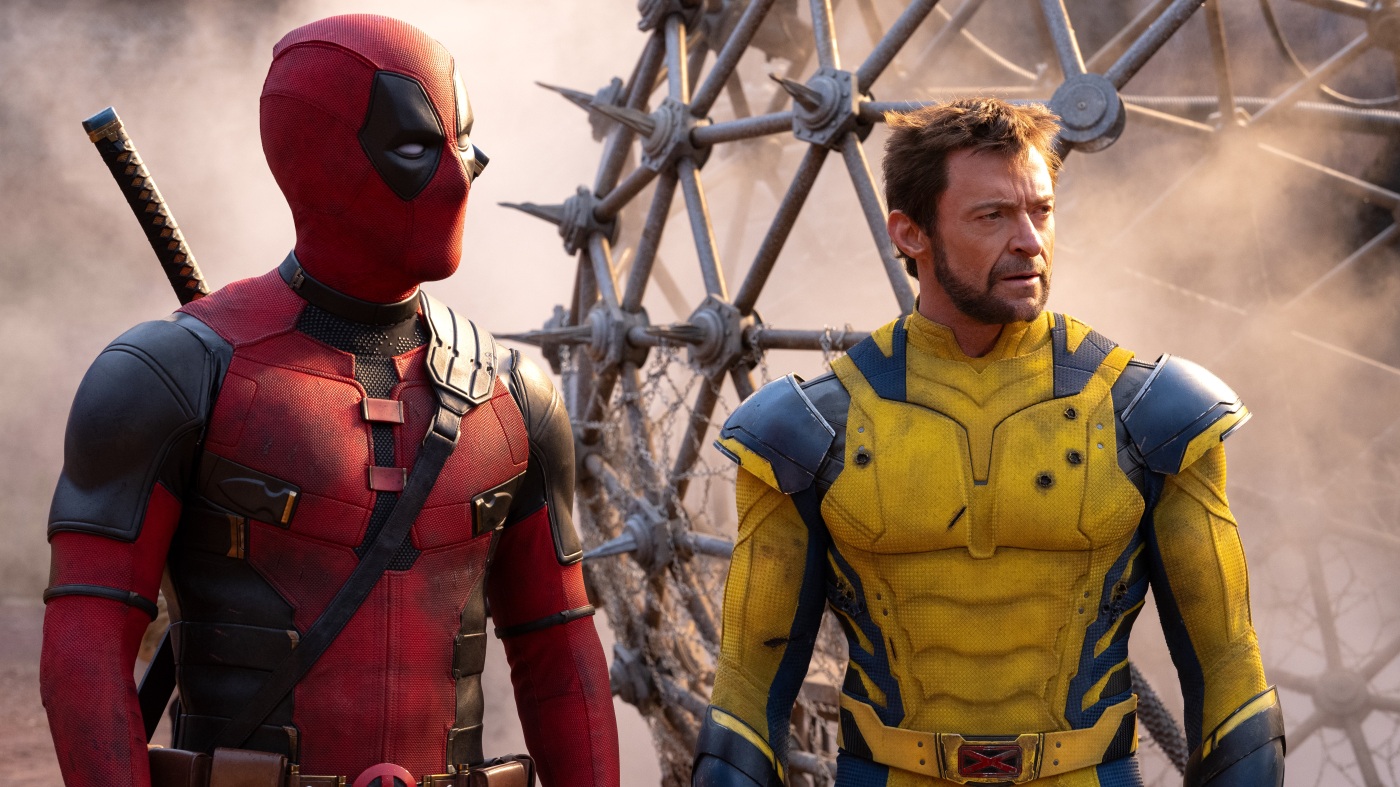Lifestyle
Everyone on dating apps wants banter. But what does that even mean?

“Looking for banter!”
It’s a dating app standard, among the Billboard Hot 100 of bio banality. Along with a passion for food, travel, plants and “The Office” (yes, still), the ability to banter, whatever that may mean, has become a common prerequisite for earning someone’s swipe right.
The number of U.S. Tinder users who listed “banter” on their profiles has grown by nearly 7% since 2022, with the word appearing significantly more often in bios of men who are 33 or older than women of the same age, according to Tinder spokesperson Tomas Iriarte Reyes. Countless articles provide prompts and advice on how to amp up the banter on dating apps. Reddit threads help introverts banter like the pros or suggest ways one can boost a conversation’s banter quotient. The fictional dating app in Apple TV’s “Ted Lasso” is even called Bantr.
But what is banter really? And what is it good for?
Sex educator Shan Boodram, Bumble’s resident sex and relationships expert and workshop facilitator on Netflix’s UK-based dating show “Too Hot to Handle,” notes that the word “banter” is thrown around more frequently in the UK. The popularity of British reality shows like “Too Hot to Handle” and “Love Island” may have contributed to the word’s adoption stateside.
Boodram says that banter encompasses two of the most consistent factors that contribute to a relationship’s longevity. “Agreeableness and willingness to meet each other’s bids,” she says. She explains the latter as “You scratch my back and I will scratch yours. In 2023, this also means you watch my saved TikTok with interest, and I will watch yours.”
The majority of roughly 100 dating app users I surveyed about banter using an online form noted that the presence of a quick back-and-forth established intellectual parity, comedic compatibility and similar interests. It’s a way to test boundaries, casually introduce personal details that may be deal-breakers and create intimacy. Even those who didn’t explicitly look for bios that mentioned banter wanted everything that banter represents. About a third said they preferred bios that included the term. Boodram explains that just like our animal kingdom peers whose mating rituals include funny little dances and call-and-response trills, we’ve concocted our own ways to signal interest and push for reciprocity through play.
“It’s romance movie terminology,” says Erin Carlon, author of “I’ll Have What She’s Having,” a deep-dive into the Nora Ephron canon. She explains that as romance novels boomed in popularity over the pandemic, the language they employed seeped into the general cultural consciousness, and in turn, onto dating apps. That, along with movies like Ephron’s “You’ve Got Mail” and “When Harry Met Sally” and later cruder comedies like “Wedding Crashers” and “Anchorman: The Legend of Ron Burgundy” led Gen-Xers and millennials to believe that we crave, and could even have, the verbal dexterity and impeccable rapport of scripted characters.
At its most thrilling, banter mimics the buildup and climax of good sex. According to Carlson, tension-filled banter was Hollywood’s answer to the enactment of puritanical movie production guidelines in the 1930s — if sex itself was a no-go, charged dialogue was the next best thing.
It’s “sex without having sex,” says Christopher Cartmill, the head of dramaturgy at Rutgers University. He points to the 1980s television show “Moonlighting” and its equally chatty 1940s cinematic predecessor “His Girl Friday” (and Shakespeare’s “Taming of the Shrew”) as examples of hardcore badinage serving as a viable substitute for the boudoir.
In those examples, the straight couples proved their attentiveness through their quick wit and evenly matched cruelty. It’s two proud people conceding that they’ve found the one person who can see through their steely exterior. And the result can be better than sex.
Which, if you’re an asexual like Alexis Bates, 26, of Waco, Texas, is part of banter’s appeal. She explains that she and her current “datemate” will fake fights and improv their way through an argument to reach mutual release. However, she adds, there’s no ill will. In fact, their openness to poke fun at each other and be goofy and vulnerable is a testament to the safety and kinship they’ve found in each other. “It’s cathartic,” she says. “The body registers that we’ve argued, we’ve had these little skirmishes, and we’re fine. It continues to build the healthy relationship.”
Despite its omnipresence on dating apps, banter isn’t inherently flirtatious or sexual. The Oxford English Dictionary defines it as “mocking, humorous, or arch remarks made about people or things to expose their shortcomings and to make them appear laughable; humorous ridicule; (also) good-humoured teasing or raillery, witty or amusing repartee.” And nearly all respondents to my survey wrote that outside of dating apps, they bantered with friends, family or colleagues (or all the above). It’s a catchall term used to describe everything from a team’s locker room dynamics, to gossip at a middle school girl’s sleepover, to a comedian’s crowd work, to Aaron Sorkin’s workplace dialogue, to the chummy buffoonery of “Seinfeld.”
Which makes asking for banter on a dating app something of a guessing game. Are men looking for a shrewd dame with a wickedly sharp sense of humor and a dynamite body, are they looking for the Pam to their Jim, a co-conspirator for life who’s goofy and charming, or are they looking for a “cool girl,” what Gillian Flynn describes in “Gone Girl” as a “funny woman who adores football, poker, dirty jokes, and burping, who plays video games, drinks cheap beer, loves threesomes and anal sex.”
Maybe what they really want is a true friend. And given that there’s been a drastic decline since 1990 in the number of close friendships men have, it makes sense that they’d ask for the same buddy-buddy ribbing where it’s easiest to search for new connections.
Or maybe they’re looking for all four in one.
Studies researching humor and romance in heterosexual relationships have found that both men and women view having a sense of humor as an asset. Hinge’s love and connection expert, therapist Moe Ari Brown, says that “92% of Hinge daters consider a shared sense of humor to be an important factor when considering being in a relationship with someone.”
But a sense of humor doesn’t mean the same thing for everyone. According to a 2015 study published in “Evolutionary Psychology,” which replicated a 2006 study, men seem to want women who will laugh at their jokes and women want men who will make them laugh. (I’ve even seen men write that they’re “looking for someone to laugh at my jokes” in their bios, and survey respondents who do not limit their dating app parameters by gender noticed this sentiment far less frequently among women and nonbinary users.)
“When guys are like ‘I’m funny’ in their bios, I’m like, ‘Let me be the judge of that,’” says Kate Parrish, a 38-year-old straight woman from Nashville, Tennessee who relies on Bumble for finding dates. She says that since joining dating apps after her divorce, she’s become well acquainted with matches who articulate that they’re looking for sparky dialogue but can’t carry their own weight. Still, she says she prefers men who mention banter in the profiles.
“I suspect that a lot of men who write that they want someone with good banter and a good sense of humor are actually saying that they want someone to enthusiastically talk about what they’re interested in and who laugh at their jokes even if they are offensive,” says Boodram. (Donald Trump excused the pussy grabbing comments he made on Access Hollywood in 2016 as “locker room banter,” and bullying in the workplace, at school and in the sports arena underscores a widespread willingness to excuse derogatory humor as “banter.”)
Like Parrish, I found that many men who said we had good banter were delusional in believing that they had any part in it. Our conversations weren’t so much the stuff of “Moonlighting” fan fiction as they were a game of T-ball. I’d unloaded the plastic stand, bases and mesh bag of balls from the trunk of my car, handed them the bat, and said “go get ‘em slugger” before tossing them a slow pitch. They’d hit it and name themselves MVP.
Alas, I too had once included “banter” on my profile, something of a bat signal to liberal arts majors. I’d seen it on the profiles of the kinds of men I’d wanted to match with and thought maybe if they saw that it were in my bio too, they’d identify me as a kindred spirit. Just two chatty daters with a penchant for sex jokes, bad puns and blink-or-you’ll-miss-it cultural references. I wanted the Harry to my Sally and asked for the one thing I knew I could deliver.
It didn’t work.
Ultimately, “banter” is nothing more than a buzzword, the 2024 answer to the “sapiosexual” craze where online daters peacocked their degrees by designating their sexual preference as “intellectuals.” It’s a Boy Scout badge for chemistry earned through acing a written test alone, a promise of something you may not be able to deliver once the memes and GIFs give way to a cup of coffee or a walk in the park. Or as Carlson says, “Men have always looked for smart and funny women. This is just a different way of saying it.”

Lifestyle
'Wait Wait' for July 27, 2024: With Not My Job guest Kathleen Hanna

Kathleen Hanna of The Julie Ruin performs onstage at the 2016 Panorama NYC Festival – Day 2 at Randall’s Island on July 23, 2016 in New York City. (Photo by Nicholas Hunt/Getty Images)
Nicholas Hunt/Getty Images/Getty Images North America
hide caption
toggle caption
Nicholas Hunt/Getty Images/Getty Images North America
This week’s show was recorded in Chicago with host Peter Sagal, judge and scorekeeper Bill Kurtis, Not My Job guest Kathleen Hanna and panelists Meredith Scardino, Peter Grosz, and Mo Rocca Click the audio link above to hear the whole show.
Who’s Bill This Time
Momala Takes Over; Assigned Seats Are Back; And The Heat Is On
The Olympic Torch Reporch
Our Summer Olympics Preview
Bluff The Listener
Our panelists tell three stories about someone committing an office faux pas, only one of which is true.
Not My Job: We quiz Bikini Kill’s Kathleen Hanna on Hanna-Barbera
Punk icon Kathleen Hanna plays our game called, “Kathleen Hanna Meet Hannah-Barbera.” Three questions about the animation studio.
Panel Questions
Hide Your Receipts; VR Meets ER; Avocado Apologies
Limericks
Bill Kurtis reads three news-related limericks: Situation Room Cocktails; Burrito Bird; Hopped Up Sharks
Lightning Fill In The Blank
All the news we couldn’t fit anywhere else
Predictions
Our panelists predict what will be the big story out of the Paris Olympic Games
Lifestyle
L.A. Affairs: At 77, I had a crush on my best friend’s widower. Did he feel the same way?

At 77, I had given up. After two failed marriages and years of unsuccessful dating, I accepted what seemed to be my fate: single for almost 40 years and single for however many remained. You don’t get it all, I told myself. I was grateful for family, friends and work. Life settled into what felt like order.
Until Ty.
As the husband of my best friend, he was no stranger, but he was usually peripheral. Then 10 years ago, my friend got lung cancer. I watched during visits, stunned at how nurturing Ty could be, taking care of her even though they had separated years before at her request.
After she died, Ty and I stayed in touch sporadically: a surprise sharing of his second granddaughter a year after we scattered my friend’s ashes, an invitation to the launch of my book a year later. Ty attended, hovering in the back, emerging after everyone left to attentively help load my car.
Two more years passed. During quiet moments, I remembered his sweetness. I also remembered his handsome face and long, tall body. Confused about what I wanted, I texted Ty, who’s an architect, under the guise of purchasing a tree for my backyard.
We spent an afternoon at the nursery, laughing, comparing options and agreeing on a final selection. When the tree arrived, I emailed a photo. He emailed a thank you.
Another three years passed, broken only by news of his third granddaughter and my memories of how good it felt to be with him. Alert to his attentiveness, but unsettled by both his remove and my growing interest, I risked reaching out again, this time about remodeling my garage.
Ty spent several hours at my house making measurements, checking the foundation and sharing pictures of his home in Topanga. His sketches for the garage arrived two weeks later via email.
I was grateful for his help but unsure over what sort of friendship we were developing, at least from his point of view. I, however, was clear. I wanted him to wrap his long arms around me, tell me sweet things and make me his.
Instead, I sent a gift card to a Topanga restaurant to thank him for his drawings.
“Maybe we should spend it together,” he texted.
We dined in the dusk of late summer. Our talk was easy. Discomfort lay in the unspoken. Anxious for clarity, I repeatedly let my hand linger near the candle flickering in the middle of our table. It remained untouched.
And that was as far as I was willing to go. I refused to be any more forward, having already compromised myself beyond my comfort level with what seemed, at least to me, embarrassingly transparent efforts to indicate my interest. Not making the first move was very important. If a man could not reach out, if he didn’t have the self-confidence to take the first step, he would not, I adamantly felt, be a good partner for me.
Two weeks later, Ty did email, suggesting an early evening hike in Tuna Canyon in Malibu. The setting was perfect. Sun sparkled off the ocean. A gentle breeze blew. We climbed uphill for sweeping coastal vistas and circled down to the shade of live oaks, touching only when he took my hand to steady me where the path was slippery. At the end of the trail, overlooking the juncture between the mountains and the sea, we stood opposite each other and talked animatedly for almost an hour, both of us reluctant to part.
Our conversation was engaging, but my inner dialogue was louder. When, I kept thinking, is this man going to suggest we continue the evening over dinner? We didn’t have to go out. We could eat at his house. It was 7 p.m., for God’s sake. Passing hikers even stopped to remark on our matching white hair and how well they thought we looked together. It was like a movie scene where the audience is yelling, “Kiss her, kiss her,” rooting for what they know is going to happen while the tension becomes almost unbearable. But bear it I did.
Each of us ate alone.
A few weeks later, at his suggestion, we were back at Tuna Canyon. This time Ty did invite me to end the evening at his house. Sitting close on his couch, but not too close, we drifted toward each other in the darkening room. His shoulder brushed mine reaching for his cup of coffee. My hip pressed his as I leaned in for my tea. Slowly, sharing wishes and hopes for our remaining years, we became shadows in the light of the moon. And in that darkness, in that illuminated space, he reached out.
This reticent man, this man who was so slow to move toward me, this sensitive man who hid himself behind layers so opaque I was unsure of his interest, released all that he had inside him.
“I wanted you,” Ty repeated again and again. “I was afraid of ruining things. You were her best friend. I didn’t want to lose your friendship.”
Our pent-up tension exploded.
Stunned and thrilled, I leaned into the space he opened.
Three years later, it is a space we continue to share: a place where neither of us has given up, a place where he wraps me in his long arms, a place we hold carefully against our diminishing days.
The author is the owner of a preschool in Venice as well as a psychotherapist, photographer and writer. Her first book, “Naked in the Woods: My Unexpected Years in a Hippie Commune,” was published in 2015. Her newest manuscript, “Bargains: A Coming of Aging Memoir Told in Tales,” is seeking a publisher. She lives in Mar Vista and can be found at margaretgrundstein.com, Instagram @margwla, Medium @margaretgrundstein and Substack @mgrundstein.
L.A. Affairs chronicles the search for romantic love in all its glorious expressions in the L.A. area, and we want to hear your true story. We pay $400 for a published essay. Email LAAffairs@latimes.com. You can find submission guidelines here. You can find past columns here.
Lifestyle
'Deadpool & Wolverine' is a self-cannibalizing slog

Ryan Reynolds stars as Deadpool and Hugh Jackman as Wolverine in an odd-couple action hero pairing.
Jay Maidment/20th Century Studios
hide caption
toggle caption
Jay Maidment/20th Century Studios
When Fox Studios released the first Deadpool movie back in 2016, it played like an irreverently funny antidote to our collective comic-book-movie fatigue. Wade Wilson, or Deadpool, was a foul-mouthed mercenary who obliterated his enemies and the fourth wall with the same gonzo energy.
Again and again, Deadpool turned to the camera and mocked the clichés of the superhero movie with such deadpan wit, you almost forgot you were watching a superhero movie. And Ryan Reynolds, Hollywood’s snarkiest leading man, might have been engineered in a lab to play this vulgar vigilante. I liked the movie well enough, though one was plenty; by the time Deadpool 2 rolled around in 2018, all that self-aware humor had started to seem awfully self-satisfied.
Now we have a third movie, Deadpool & Wolverine, which came about through some recent movie-industry machinations. When Disney bought Fox a few years ago, Deadpool, along with other mutant characters from the X-Men series, officially joined the franchise juggernaut known as the Marvel Cinematic Universe.
That puts the new movie in an almost interesting bind. It tries to poke fun at its tortured corporate parentage; one of the first things Deadpool says is “Marvel’s so stupid.” But now the movie also has to fit into the narrative parameters of the MCU. It tries to have it both ways: brand extension disguised as a satire of brand extension.

It’s also an odd-couple comedy, pairing Deadpool with the most famous of the X-Men: Logan, or Wolverine, the mutant with the unbreakable bones and the retractable metal claws, played as ever by a bulked-up Hugh Jackman.
The combo makes sense, and not just because both characters are Canadian. In earlier movies, Deadpool often made Wolverine the off-screen butt of his jokes. Both Deadpool and Wolverine are essentially immortal, their bodies capable of self-regenerating after being wounded. Both are tormented by past failures and are trying to redeem themselves. Onscreen, the two have a good, thorny chemistry, with Jackman’s brooding silences contrasting nicely with Reynolds’ mile-a-minute delivery.
I could tell you more about the story, but only at the risk of incurring the wrath of studio publicists who have asked critics not to discuss the plot or the movie’s many, many cameos. Let’s just say that the director Shawn Levy and his army of screenwriters bring the two leads together through various rifts in the multiverse. Yes, the multiverse, that ever-elastic comic-book conceit, with numerous Deadpools and Wolverines from various alternate realities popping up along the way.

I suppose it’s safe to mention that Matthew Macfadyen, lately of Succession, plays some kind of sinister multiverse bureaucrat, while Emma Corrin, of The Crown, plays a nasty villain in exile. It’s all thin, derivative stuff, and the script’s various wink-wink nods to other shows and movies, from Back to the Future to Furiosa to The Great British Bake Off, don’t make it feel much fresher. And Levy, who previously directed Reynolds in the sci-fi comedies Free Guy and The Adam Project, doesn’t have much feel for the splattery violence that is a staple of the Deadpool movies. There’s more tedium than excitement in the characters’ bone-crunching, crotch-stabbing killing sprees, complete with corn-syrupy geysers of blood.

For all its carnage, its strenuous meta-humor and an R-rated sensibility that tests the generally PG-13 confines of the MCU, Deadpool & Wolverine does strive for sincerity at times. Some of its cameos and plot turns are clearly designed to pay tribute to Fox’s X-Men films from the early 2000s.
As a longtime X-Men fan myself, I’m not entirely immune to the charms of this approach; there’s one casting choice, in particular, that made me smile, almost in spite of myself. It’s not enough to make the movie feel like less of a self-cannibalizing slog, though I suspect that many in the audience, who live for this kind of glib fan service, won’t mind. Say what you will about Marvel — I certainly have — but it isn’t nearly as stupid as Deadpool says it is.

-

 World1 week ago
World1 week agoOne dead after car crashes into restaurant in Paris
-

 Midwest1 week ago
Midwest1 week agoMichigan rep posts video response to Stephen Colbert's joke about his RNC speech: 'Touché'
-

 News1 week ago
News1 week agoVideo: Young Republicans on Why Their Party Isn’t Reaching Gen Z (And What They Can Do About It)
-

 Movie Reviews1 week ago
Movie Reviews1 week agoMovie Review: A new generation drives into the storm in rousing ‘Twisters’
-

 News1 week ago
News1 week agoIn Milwaukee, Black Voters Struggle to Find a Home With Either Party
-

 Politics1 week ago
Politics1 week agoFox News Politics: The Call is Coming from Inside the House
-

 News1 week ago
News1 week agoVideo: J.D. Vance Accepts Vice-Presidential Nomination
-

 World1 week ago
World1 week agoTrump to take RNC stage for first speech since assassination attempt















